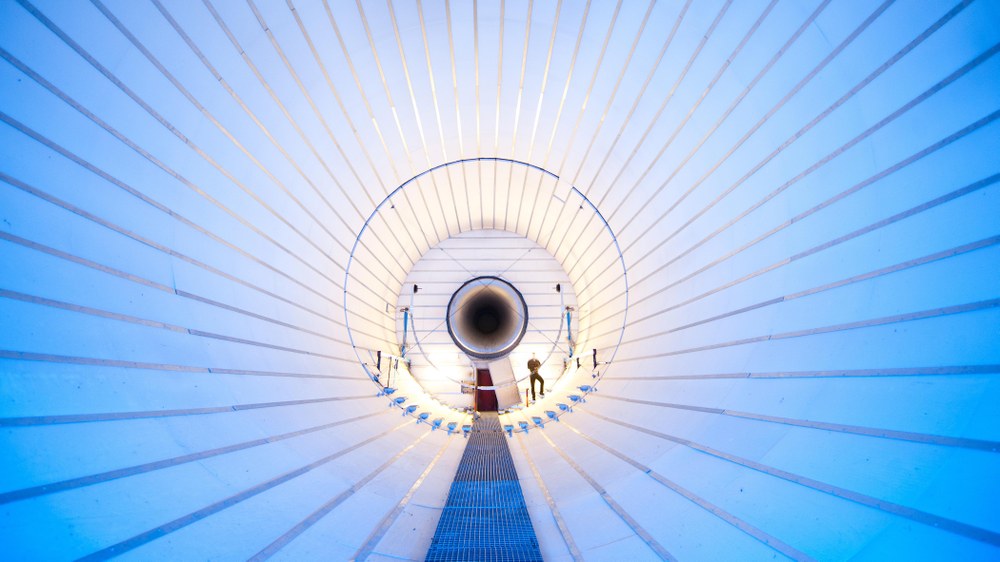High-pressure air fights aircraft noise – compressed air substantially reduces engine noise


The large blades of the fan dominate when looking at an aircraft engine from the front. They are also among the largest producers of in-flight noise. Researchers conducting trials at the German Aerospace Center (Deutsches Zentrum für Luft- und Raumfahrt; DLR) have now succeeded in demonstrating, for the first time anywhere in the world, that fan noise can be reduced substantially by introducing compressed air. To do this, they developed a method that blows air through several perforated rings fitted behind the fan to create noise cancellation that reduces the sound produced by the fan.
Volume almost halved
"This compressed air method has allowed us to reduce the particularly annoying rotor-stator noise that emerges from the engine at critical emission angles by up to 10 decibels. In terms of human perception, this is approximately equivalent to halving the volume," says Lars Enghardt from the DLR Institute of Propulsion Technology. "By far the most irritating noise produced at the engine intake is created where the main fan spins at high speed in front of an additional row of fixed-position blades, referred to as the stator," Enghardt continues.
Quieter all round
The experiments were performed in the experimental Ultra High Bypass Ratio (UHBR) compressor test system in Cologne, operated by the DLR Institute of Propulsion Technology. "We analysed the compressed air method using a realistic partial engine model installed in the test system and operated at a low rotational speed under normal approach conditions," says Eberhard Nicke, describing the experiment. To measure the volume, the researchers installed a frame fitted with microphones in front of the engine model. Then they moved the microphone frame in increments until they had covered every possible position in front of the intake. “It was particularly important that the manner in which we controlled noise cancellation ensured a reduction in volume in every possible direction of emission, and not just one; and we succeeded," says Enghardt, who heads up the Engine Acoustics Department in Berlin.
Active noise reduction
Researchers have been exploring means of making engines quieter for some time now, pursuing active noise reduction as an innovative technology. "Active noise reduction involves the use of noise cancellation sources to suppress the output of the primary noise emitters. Initially, the methods used loudspeakers to produce a noise cancellation field. However, a system consisting of a large number of loudspeakers would have to be extremely robust, durable and reliable to be fitted to an engine, for instance at the intake. Furthermore, the use of high-performance magnets and amplifiers substantially increases the engine weight, which has negative repercussions on its efficiency," says Enghardt, explaining the disadvantages. This prompted the acoustic specialists at the DLR Institute of Propulsion Technology to design an innovative procedure to use compressed air as a means of actively reducing engine noise. The air this introduces exerts alternating forces on the guide vanes behind the main fan, creating active noise cancellation, provided that the air supply is controlled precisely. Project partner Airbus Group Innovations used the underlying principle to build a computerised control system that precisely and automatically adjusts the ideal circumferential position that the two rings adopt, and also how much air they introduce.
Besides being lightweight, the new system comes with the advantage that, compared with the loudspeaker solution, is easier to integrate into modern engine designs. Modern aircraft engines already have a compressed air system designed for a variety of purposes, which can be upgraded and adapted for acoustic applications. Initial DLR tests conducted on the new compressed air technique back in 2012 had already shown, in principle at least, that this method would be suitable for noise cancellation. At the time, the experiment was conducted in cooperation with the two industrial partners, Rolls-Royce Germany and Airbus Group Innovations, as part of the Aerospace Research Programme IV funded by the German Federal Ministry for Economic Affairs and Energy (Bundesministerium für Wirtschaft und Energie; BMWi).
Interdisciplinary aircraft noise research
As Germany's foremost aerospace research organisation, DLR conducts intensive and complex research on issues relating to aircraft noise, and is therefore a sought after partner for industry, politics, public administration, civic affected parties and environmental groups. Research into aircraft noise and new options for active noise suppression represent a distinctly interdisciplinary field that requires specialist knowledge in a broad variety of disciplines such as physics, engineering, medicine, psychology and transport studies. Active across – and as a connecting link between – all the relevant disciplines, DLR is already at the forefront of aircraft noise research. DLR established a specialist committee on aircraft noise in 2014, tasked with increasing research in this field, introducing greater collaboration and actively addressing outstanding issues.

